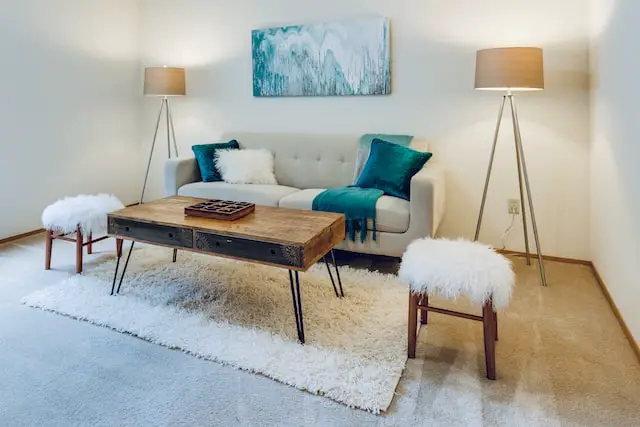Eclectic refers to a style that incorporates various elements from different sources or styles, while bohemian is a style that embraces a free-spirited, non-conformist, and artistic lifestyle often associated with unconventional clothing, patterns, and colors.
Eclectic
(Photo by Francesca Tosolini on Unsplash )

Eclectic refers to a style or approach that combines various elements from different sources or styles, creating a unique and diverse composition. It often involves the use of contrasting colors, textures, and patterns to achieve a harmonious yet dynamic aesthetic. An eclectic space is put together with intention. It’s a mix of different elements that come together to create a cohesive look. There is usually a unifying factor that ties the room together, whether it’s a certain color palette or style of furniture. Even though an eclectic room might have many different patterns and textures, it will still feel purposeful and put-together.
Bohemian
(Photo by Sarah Brown on Unsplash )

Bohemian style is often inspired by nature, with lots of earthy tones and natural materials. It’s also common to see vintage and antique pieces in a bohemian home, as they add to the overall feeling of being “unpretentious”. This style is all about creating a space that feels comfortable and inviting, where you can truly relax and be yourself. Bohemian spaces are more carefree and relaxed. They tend to be filled with items that have sentimental value or were collected from travels. The overall vibe is cozy and lived-in, with a focus on comfort over formality. Bohemian styles can also be incorporated into other aesthetics, like the industrial look we mentioned earlier.
Eclectic Vs. Bohemian – Key differences
Eclectic and bohemian are two distinct styles with some similarities. Some key differences between the two are:
- Eclectic style incorporates elements from various sources and styles, while bohemian style has a more specific aesthetic that embraces a free-spirited, non-conformist, and artistic lifestyle.
- Eclectic style tends to be more structured and balanced, while bohemian style is more fluid and organic.
- Eclectic style can incorporate a wide range of colors, patterns, and textures, but bohemian style often features bold and vibrant colors, intricate patterns, and a mix of textures such as wool, silk, and leather.
- Eclectic style can be achieved through carefully curated pieces that complement each other, while bohemian style often involves layering and mixing pieces in a seemingly haphazard but intentional way.
Overall, while both eclectic and bohemian styles can incorporate a mix of elements and have a unique aesthetic, they differ in their level of structure, specific design elements, and the overall feeling they convey.
What is considered eclectic style?
Eclectic style is a design approach that involves combining elements from various styles, eras, and sources to create a unique and harmonious whole. It is a mix-and-match style that celebrates diversity and creativity.
In an eclectic design scheme, you might see a vintage rug paired with a modern sofa, a contemporary painting on a traditional wallpapered wall, and a variety of textures and patterns working together. The key to achieving an eclectic style is to create a balance between the different elements, so they don’t clash with each other.
Some common features of eclectic style include:
- Use of contrasting colors, patterns, and textures
- Mixing of old and new, high-end and low-end pieces
- Combining different styles, such as modern and traditional, rustic and industrial
- Incorporating artwork, textiles, and decorative objects from different cultures and eras
The beauty of eclectic style is that it allows for personal expression and creativity, making it a popular choice for those who want to showcase their individuality in their home decor.
What is considered Bohemian style?
Bohemian style, also known as boho style, is a fashion and home décor trend that celebrates a free-spirited, unconventional, and artistic lifestyle. It is inspired by the bohemian movement of the mid-19th century, which rejected the mainstream culture and embraced a more bohemian, nomadic lifestyle.
In fashion, bohemian style is characterized by flowing, loose-fitting clothing made from natural fabrics such as cotton, linen, and silk. It often features bold and vibrant colors, intricate patterns, and a mix of textures such as wool, leather, and lace. Accessories such as oversized hats, fringe bags, and chunky jewelry are also common in bohemian fashion.
In home décor, bohemian style is characterized by a relaxed, eclectic, and cozy vibe. It features a mix of vintage and modern pieces, colorful textiles, and a variety of patterns and textures. Common elements of bohemian décor include patterned rugs, woven wall hangings, floor cushions, and a variety of plants. The overall look is often eclectic, yet harmonious.
Overall, bohemian style is about celebrating individuality and creativity, embracing a carefree and adventurous spirit, and incorporating a mix of elements that reflect personal style and cultural influences.
What are the 5 bohemian class types?
There are 5 bohemian class types: the original bohemians, the countercultural bohemians, the business bohemians, the academic bohemians, and the artistic bohemians.
Original Bohemians: The first wave of Bohemianism began in the early 19th century and was closely associated with Romanticism. These Bohemians were artists, writers, musicians, and actors who rejected conventional bourgeois society and lived lives of poverty and creativity.
Countercultural Bohemians: The second wave of Bohemianism emerged in the late 19th century and was closely associated with the rise of avant-garde movements such as Dadaism and Surrealism. These Bohemians were radicals who sought to subvert conventionality through their art, often shocking mainstream society in the process.
Business Bohemians: The third wave of Bohemianism began in the mid-20th century and was characterized by an embrace of capitalism. This new breed of Bohemian was less interested in art and more interested in making money; they were often successful entrepreneurs or financiers.
Academic Bohemians: The fourth wave of Bohemianism arose in the 1960s and 1970s among college students and young intellectuals. These individuals were often involved in left-wing politics and embraced alternative lifestyles such as communal living and sexual exploration.
Artistic Bohemians: The fifth and final wave of Bohemianism is currently underway; it is characterized by a return to a focus on artistic and cultural pursuits. This wave of bohemianism has been influenced by technology and globalization, as well as a growing interest in sustainability and social justice.
How do you dress eclectic?
There is no set formula for dressing eclectic, as it is all about mixing and matching different styles to create a unique look. However, there are some key pieces that can help to create an eclectic aesthetic. These include vintage items, statement pieces, and items with an unusual print or pattern. To put together an eclectic outfit, start by choosing one key piece, then build the rest of the outfit around it. For example, you could start with a vintage dress, then add a leather jacket and some funky jewelry to finish the look.
What is new bohemian style?
New bohemian style is a mix of vintage and modern, often with a focus on organic materials and natural colors. It’s a more relaxed approach to styling than the traditional bohemian look, and it often incorporates elements from different cultures.
Who are eclectic people?
Eclectic people are those who have a wide range of interests and tastes, and who draw inspiration from various sources and styles. They often have an open-minded and curious approach to life, seeking out new experiences and ideas.
In terms of their personal style, eclectic people often have a unique and distinctive look, combining elements from different styles and eras to create a cohesive and balanced whole. They may mix high-end and low-end pieces, and incorporate vintage or handmade items into their wardrobe.
Eclectic people may also have diverse hobbies and interests, such as playing multiple musical instruments, practicing various forms of art, or engaging in different sports and outdoor activities. They enjoy exploring new cultures and ideas, and may be well-traveled or multilingual.
Overall, eclectic people are known for their creativity, individuality, and willingness to experiment and try new things. They celebrate diversity and embrace the richness of different cultures and perspectives.
Featured Image By – Alexander Schimmeck on Unsplash








